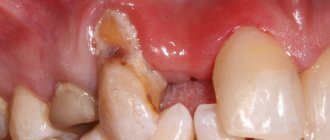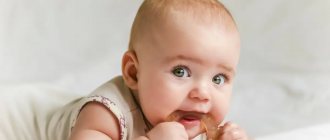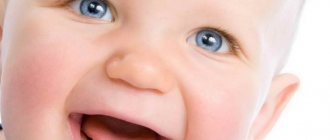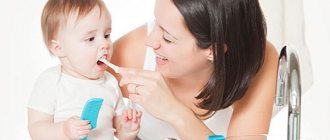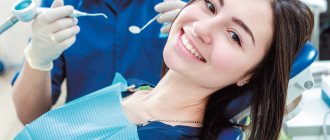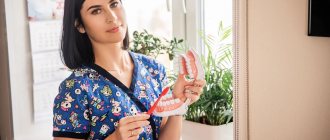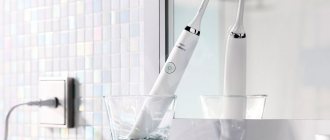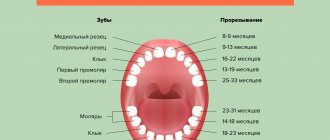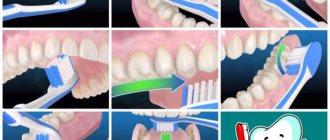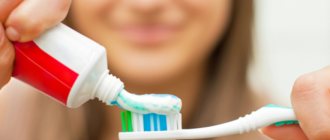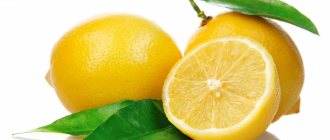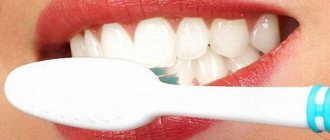The health of molars cannot but depend on oral hygiene in early childhood. To avoid frequent meetings between your baby and the dentist, it is recommended to brush your teeth regularly.
Parents quite often have a question: at what age do children have their teeth brushed? The baby's teeth should begin this procedure as early as possible, after the appearance of the first incisor. Typically, they appear at the age of 3-10 months.
If hygiene procedures begin at about three months of age, the baby will quickly get used to the manipulation. A slight pressure on the gums will serve as a massage and relieve itching during teething. And this will also prevent stomatitis, because it is from this age that the baby tries to taste hands and rattles.
Many parents associate the beginning of the procedure with the appearance of the first incisor. A simple way to determine whether a tooth has erupted is to knock on it with a spoon. But leaving during this period should be delayed. An awkward touch to the inflamed gum can cause pain.
Does my child need to brush his teeth?
There is an opinion in parent circles that there is no need to care for baby teeth.
By basing their opinion on the phrase “they will fall out anyway,” adults are mistaken. The oral cavity is an ideal place for bacteria to live and multiply. Failure to maintain hygiene leads to diseases of the gums and oral mucosa. With saliva, some microorganisms enter the stomach, sometimes causing inflammation and diseases of internal organs.
Leftover food is a breeding ground for microorganisms, which, in the process of life, form plaque. Acids are released from it. Exposure to acids released by plaque destroys thin enamel.
This leads to the formation of caries. A carious tooth is a source of bacteria and infections that can lead to stomatitis, pulpitis, and cause pain or discomfort in a child.
Teeth affected by caries are not only unsightly. They can lead to infection of the molars, which are located in the gums. And the early loss of baby teeth sometimes leads to improper eruption of permanent teeth, curvature and asymmetry of the bite.
Structural features
The process of formation of dental units in the fetus begins at the end of the first trimester of pregnancy. At this moment they are most susceptible to the influence of external and internal factors. Teething, despite the generally accepted timing and sequence, can occur at different times depending on the individual characteristics of the newborn. At about 3 years of age, the formation of the mixed dentition is completely completed, and the baby has 8 incisors, 4 canines and 8 molars (20 in total).
Resembling the structure and shape of molars (consisting of enamel, dentin, pulp), baby teeth do not have the same strength, and their outer hard layer is much thinner. They also have the following features:
- small crown size;
- divergent root system, which resolves before changing the row to a permanent one;
- large volume of loose connective tissue;
- wide channels.
Many people mistakenly believe that the first dental units do not have roots, but this is nothing more than a myth. The dairy ones have exactly the same number as the regular ones.
Cleaning Rules
As the baby grows, hygiene attributes also change. Choosing them is not an easy task.
But even the safest brush can cause harm if you do not follow simple rules:
- The chewing surface is cleaned with circular movements, and the front part - only with vertical movements.
- The tongue also needs cleaning.
- Wash the brush thoroughly and do not forget to replace it with a new one regularly (once every 3 months).
- Dentists recommend brushing your teeth twice a day.
- The duration of the procedure should not exceed three minutes.
First year of life
When you hear the ringing sound of a spoon touching the first incisor, do not rush to run for a brush.
For infants up to one year old, there are their own care products:
- silicone fingertip;
- sterile bandage;
- dental wipes.
The advantages of the listed means are that they are worn on the finger. This allows you to feel the gums and adjust the pressure.
The most inexpensive way is to use a bandage or gauze soaked in water or soda solution. A small amount of bandage is moistened, wrung out and wrapped around the finger. The gums, tongue and inner surface of the cheeks are treated.
Purchasing dental wipes will hit your pocket much more. They are intended for one-time use, treated with a special antiseptic solution that is safe for the baby. Neutral in taste, will not leave any unpleasant sensations in the baby.
Children's stores have a huge selection of silicone fingertips. For the first manipulations, it is better to choose a smooth attribute.
For older babies, you can offer finger pads with silicone bristles. They are more reminiscent of a toothbrush and massage the gums better. After each use, wash in running water. Boil before first use.
Oral care products
Before the appearance of the first incisors and molars, oral hygiene in newborns includes only wiping the gums and tongue. This way, parents can quickly remove harmful plaque and cleanse the child’s mouth of bacteria.
When the first tooth appears, it is recommended to clean it with a soft gauze swab or a special damp cloth. Even the softest brush will be unpleasant for a baby in such a delicate state.
ASEPTA BABY finger wipes from 0 to 3 years will help relieve unpleasant symptoms during teething. These amazingly pleasant massage tools will ensure gentle oral hygiene for the baby and massage the gums during teething.
- The corrugated surface of the napkins will give a light massage to the gums.
- Impregnation with plant extracts will prevent inflammation and help balance the acid-base balance of the oral cavity.
Wipes will help your baby form the habit of daily oral hygiene, providing daily pleasant procedures. ASEPTA BABY wipes will be especially convenient when traveling, because with them you can brush your teeth even in road conditions. Each napkin is individually packaged in a sealed bag, so their one-time use is 100% hygienic.
A bandage or gauze swab lightly moistened with boiled water is also suitable for wiping the first teeth of babies. Under no circumstances should you use cotton wool for daily oral hygiene in infants - this material is not suitable for their texture. Rough cotton wool will leave fibers behind, which can cause even more inflammation of the gums.
Brushing teeth after six months
In infants older than six months, the ejection reflex disappears. From this age, parents can use other means to clean their baby’s delicate teeth.
Finger toothbrush
A silicone brush will be a salvation for parents of infants. At an early age, the baby is not yet able to hold a toothbrush on his own and make the necessary movements with it, so you can brush your teeth with the help of a special fingertip.
Classic brush
A children's toothbrush is, first of all, a tool with very soft bristles. It is better that the children's brush has short and soft bristles, as well as a short and comfortable handle with which you can brush children's teeth. The first brush can be used from 1 year.
Toothpaste
Children should never brush their teeth with adult toothpaste. This hygiene product should also be selected according to the baby’s age.
For infants who are not yet receiving complementary foods, a gel-like paste with a neutral or milky taste is suitable. It is important that the product does not contain various abrasive substances, and that its taste evokes exclusively positive emotions in the baby.
An excellent means for cleaning teeth will be the children's gel paste from 0 to 3 years old ASEPTA BABY, designed for gentle care of the gums and baby teeth of babies. Children like its pleasant “tutti-frutti” taste, which makes brushing their teeth a joyful procedure and helps form a healthy habit of daily oral hygiene.
- The complex composition allows you to simultaneously care for your gums and teeth.
- The gel base provides gentle cleansing of teeth and gums.
- The paste is safe to swallow, as it does not contain components that can harm the baby's health.
ASEPTA BABY paste does not contain fluoride, therefore it does not require consultation with a doctor before use.
Second year of life
The child grows very quickly and by the age of one year he can firmly hold a toothbrush in his hands. Of course, adults will have to manage with inept hands. Rinsing a baby’s mouth is also an impossible task, so it is necessary to use a fluoride-free toothpaste.
At this age, the main criterion for choosing a brush is its safety. What to pay attention to:
- stiffness of the bristles;
- handle with anti-swallowing, non-slip handle;
- size of the working part (head).
For a little person, choose a hygiene attribute with soft but elastic bristles. Hard hairs can scratch fragile enamel and injure the gums. Preference is given to models with the same bristle height (approximately 10 mm), in 3-4 rows.
The size of the working surface should not exceed 20 mm (approximately the size of two teeth). The rounded head will prevent injury to the gums.
Bright handles with cartoon characters attract children's eyes. It is inconvenient to use an accessory with a massive handle at such a young age. To prevent the brush from slipping, manufacturers provide a rubberized or ribbed coating.
A protective ring must be required.
How to choose and how often to change a child’s first toothbrush?
Many parents worry about how to choose the first toothbrush for their child. The main thing you need to know: choose the softest artificial bristles, a small brush head area (up to 2 cm) and a massive shaped handle that fits in a child’s hand and does not slip out.
You may have already wondered how often to change your toothbrush. Brushes are changed as they wear out every few months. The size and stubble change according to the growth of children: 0–3 years, 4–7 years, 7–12 years. Gradually, from the softest bristles it reaches medium, and the head of the brush increases by several millimeters. To avoid mistakes, look at the age indicated on the packaging. Any doubts will always be resolved by your doctor.
At what age should you brush with toothpaste?
Toothpaste must be rinsed thoroughly. Children can cope with this procedure until they are two years old. The amount of paste at first should be the size of a pea.
The toothpaste for children under 3 years of age does not contain fluoride. Also, products with antiseptic components (for example, chlorhexidine or triclosan) are not suitable for daily use. They have a detrimental effect on local immunity and disrupt the microflora.
But there is nothing to worry about if your baby swallows a little baby toothpaste. The composition is absolutely harmless to health.
As a summary
Please note that until the age of 5-6 years, a child cannot brush his teeth properly on his own. Of course, you can leave everything to chance, give the baby a brush and he will fidget with it on his teeth, and the task will be completed. But there will be no benefit from this.
Remember, how you instill in early childhood the habit of caring for your teeth, this is how your child will treat them throughout his life. Therefore, it is necessary to control this process, sometimes up to 10-12 years.
Healthy smiles for your babies!
Moscow metro station Zvezdnaya, Danube Avenue, 23
Komarovsky's recommendations
The famous doctor Komarovsky recommends starting the process of oral care as early as possible.
But do not make this procedure violent. The process should give the little one pleasure and be a game. If the child resists, then you can wait until a more conscious age, up to 2-3 years. You will have to take care of your baby's teeth until he is 7 years old, until he learns to take proper care of them.
The task of parents is not to force, but to interest and teach hygiene.
But for oral health, certain conditions must be met:
- Diet mode (do not overeat at night, do not feed 24 hours a day).
- Clean cool air in the room, do not allow saliva to dry out.
- Drink clean water at night.
Each parent has the right to decide when to begin accustoming their child to daily oral care. Timely oral hygiene is the key to health and a beautiful smile.
POSSIBLE DIFFICULTIES
Sometimes teaching a child to brush their teeth is not as easy as we would like. The following difficulties are possible.
- The baby resists the penetration of the brush into his oral cavity and perceives it clearly negatively. In this case, parents will have to be patient, but persistent. You can buy a bright, beautiful brush, which at first will be perceived as a toy, and also entertain the baby with rhymes and games, trying to evoke positive emotions in him.
- The child may find it uncomfortable to hold the brush. In this case, training (“brush the teeth” of dolls and other toys), as well as classes to develop fine motor skills, will help.
- Children may experience discomfort due to the fact that very rough bristles damage their enamel, in this situation they should replace the brush with a softer one.
It is also important for parents to keep their baby's brush clean, so they should wash it at least once a week. Silicone and polymer models should not be boiled or doused with boiling water; just wash them thoroughly with soap and then let them dry. The service life of the instrument is no more than 2-3 months, however, if the baby has suffered from an infectious disease, then replacement must be made immediately. Also, if the bristles begin to spread in different directions due to overly conscientious cleaning, then the product must be replaced.
